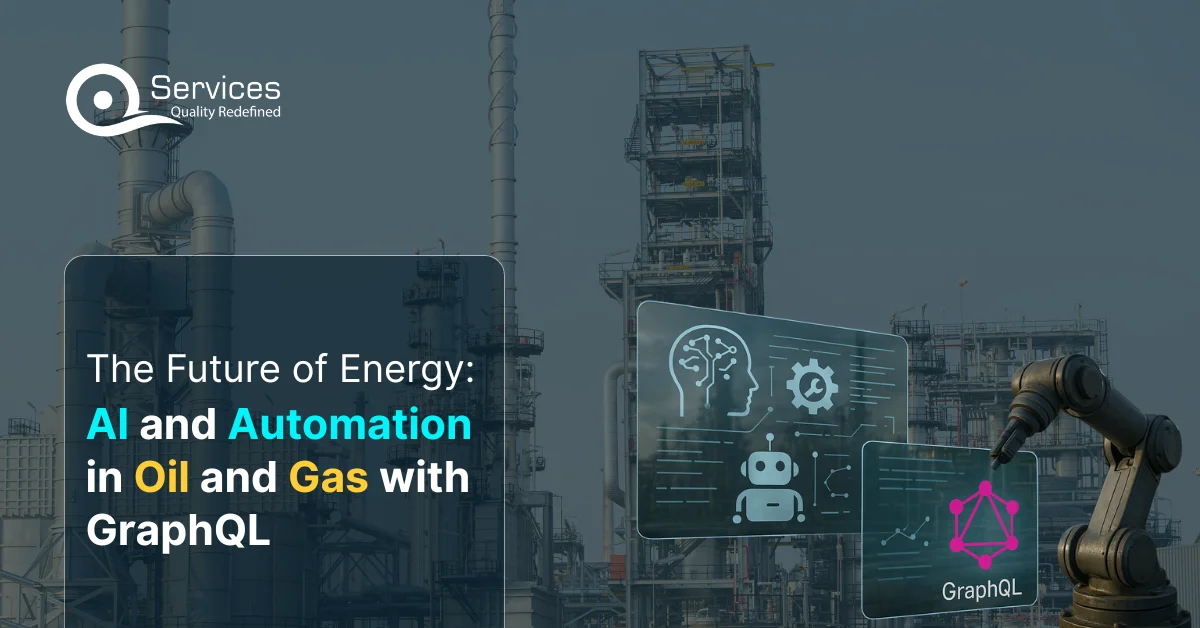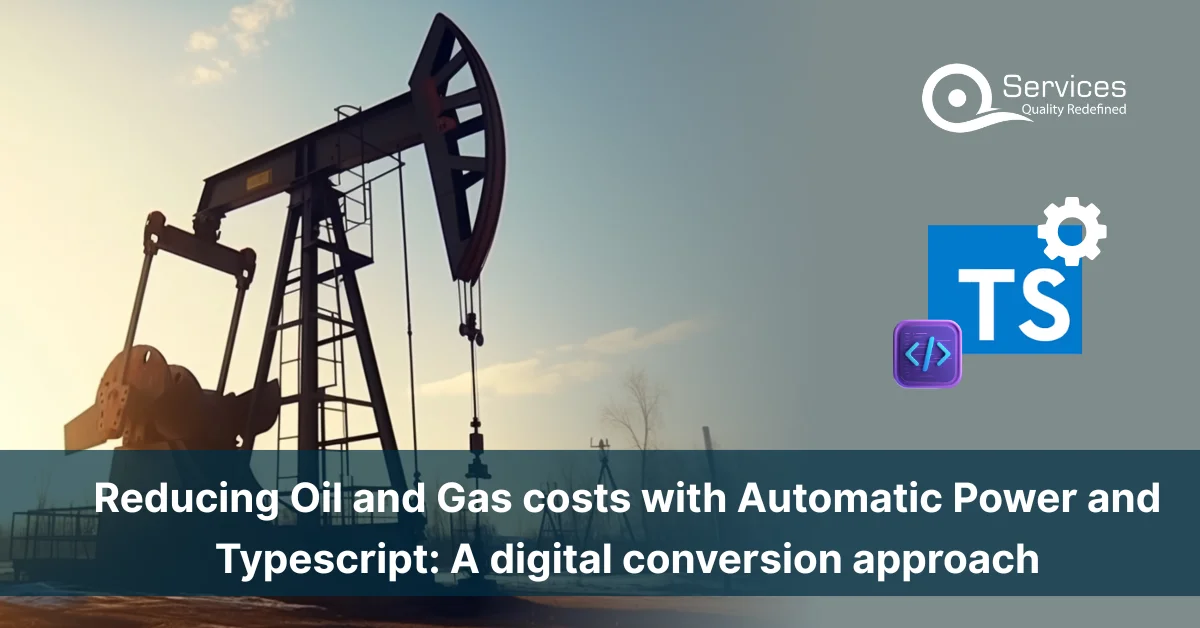
Rewards
.





CANADA
55 Village Center Place, Suite 307 Bldg 4287,
Mississauga ON L4Z 1V9, Canada
Certified Members:
.



Home » The Future of Energy: AI and Automation in Oil and Gas with GraphQL

The oil and gas industry has long been a cornerstone of the global economy, powering industries, transportation, and households. However, as the world shifts toward cleaner energy and greater efficiency, the sector faces unprecedented challenges and opportunities. The convergence of artificial intelligence (AI), automation, and modern data technologies like GraphQL is revolutionizing how this industry operates. These advancements are not only optimizing traditional processes but also paving the way for a more sustainable and data-driven future. In this blog, we’ll explore how AI, automation, and GraphQL are shaping the future of energy in the oil and gas sector, their applications, benefits, and the transformative potential they hold.
The energy sector is at a crossroads. On one hand, global demand for oil and gas remains robust, particularly in developing economies. On the other hand, environmental concerns, regulatory pressures, and the rise of renewable energy are pushing the industry to adapt. Companies are tasked with balancing profitability with sustainability, reducing operational costs, and minimizing their carbon footprint—all while maintaining safety and reliability.
This is where technology steps in. AI and automation have emerged as game-changers, enabling oil and gas companies to streamline operations, enhance decision-making, and unlock new efficiencies. Meanwhile, GraphQL, a powerful query language for APIs, is transforming how data is managed and accessed, providing the flexibility and scalability needed to support these innovations. Together, these tools are redefining the industry’s future.
Artificial intelligence is no longer a futuristic concept—it’s a practical tool driving real-world outcomes in oil and gas. From exploration to production to distribution, AI is being integrated across the value chain.
One of AI’s most significant contributions is in subsurface exploration and reservoir management. Traditionally, geologists and engineers relied on seismic data, manual analysis, and educated guesses to locate hydrocarbon deposits. Today, AI-powered algorithms analyze vast datasets—seismic surveys, geological models, and historical production data—to predict the location and size of reserves with unprecedented accuracy. Machine learning models can identify patterns that humans might miss, reducing the time and cost of exploration.
For example, AI can optimize reservoir simulations by forecasting production rates and identifying the best drilling locations. Companies like ExxonMobil and Chevron have adopted AI-driven tools to enhance their exploration efforts, resulting in fewer dry wells and higher success rates.
Equipment downtime is a major cost driver in oil and gas. Pumps, pipelines, and drilling rigs operate in harsh conditions, and unexpected failures can lead to millions in lost production. AI addresses this through predictive maintenance. By analyzing sensor data from equipment—vibration, temperature, pressure—AI models can predict when a component is likely to fail and recommend preemptive repairs. This shift from reactive to proactive maintenance minimizes downtime, extends asset life, and improves safety.
The oil and gas supply chain is complex, involving extraction, refining, transportation, and distribution. AI optimizes this process by forecasting demand, managing inventory, and identifying bottlenecks. For instance, AI can analyze weather patterns, geopolitical events, and market trends to predict oil prices and adjust production schedules accordingly. This level of foresight enables companies to operate more efficiently and respond to market shifts in real time.
Safety is paramount in oil and gas, where accidents can have catastrophic consequences. AI enhances safety by monitoring operations through drones, cameras, and sensors. Computer vision algorithms can detect leaks, equipment malfunctions, or unsafe worker behavior, triggering alerts before incidents escalate. Additionally, AI helps track emissions and optimize processes to reduce the industry’s environmental impact, aligning with global sustainability goals.
While AI provides the intelligence, automation supplies the execution. Robotics, IoT (Internet of Things), and automated systems are transforming oil and gas operations by reducing human intervention, increasing precision, and boosting efficiency.
Drilling is one of the most labor-intensive and costly aspects of oil and gas production. Automated drilling rigs, guided by AI, can adjust parameters like speed, pressure, and direction in real time, optimizing performance and reducing human error. These rigs operate 24/7, unaffected by fatigue or environmental conditions, and can drill deeper and more accurately than ever before. Companies like Schlumberger have pioneered autonomous drilling systems, cutting costs and improving well productivity.
Pipelines stretch thousands of miles across diverse terrains, making manual inspection a logistical nightmare. Automated drones and robots equipped with sensors and cameras now patrol pipelines, detecting corrosion, leaks, or structural weaknesses. Similarly, smart valves and automated control systems in refineries adjust flow rates and temperatures without human input, ensuring consistent output and energy efficiency.
Automation doesn’t eliminate jobs—it redefines them. As repetitive tasks like data entry, equipment checks, and basic maintenance are handed over to machines, workers can focus on higher-value roles like strategy, innovation, and oversight. This shift requires reskilling the workforce, but it ultimately creates a more agile and capable industry.
Get free Consultation and let us know your project idea to turn into an amazing digital product.

AI and automation generate massive amounts of data—sensor readings, production logs, market analytics, and more. Managing this data efficiently is critical to unlocking its value. Traditional REST APIs, while effective, often struggle with the complexity and volume of modern oil and gas datasets. This is where GraphQL shines.
GraphQL, developed by Facebook in 2012 and open-sourced in 2015, is a query language for APIs that allows clients to request exactly the data they need—no more, no less. Unlike REST, which requires multiple endpoints for different data types, GraphQL uses a single endpoint and a flexible schema, making it ideal for dynamic, data-intensive industries like oil and gas.
In the oil and gas sector, GraphQL serves as a bridge between disparate systems—legacy infrastructure, IoT devices, AI models, and cloud platforms. Here’s how it’s making an impact:
Drilling rigs, pipelines, and refineries produce real-time data streams. GraphQL enables engineers to query this data instantly, retrieving specific metrics (e.g., pressure readings from a single well) without overloading systems with unnecessary information.
Many oil and gas companies rely on decades-old IT systems that don’t communicate seamlessly with modern tools. GraphQL acts as a unified layer, pulling data from legacy databases and presenting it alongside new inputs, such as AI predictions or IoT sensor readings.
As operations grow, so does the complexity of data management. GraphQL’s schema-based approach scales effortlessly, accommodating new data sources without requiring extensive backend rewrites.
Teams across exploration, production, and distribution often work with different datasets. GraphQL allows them to access a shared data pool, fostering collaboration and reducing silos.
For example, an engineer monitoring a North Sea oil platform could use GraphQL to pull real-time production stats, historical maintenance records, and AI-generated forecasts into a single dashboard—all with one query. This level of efficiency was unimaginable with traditional APIs.
The true power of these technologies lies in their integration. AI analyzes data to provide insights, automation acts on those insights, and GraphQL ensures the data flows seamlessly between systems. Consider this scenario:
This synergy reduces costs, enhances safety, and accelerates project timelines. It’s a blueprint for how the oil and gas industry can thrive in an increasingly competitive and regulated world.
The adoption of AI, automation, and GraphQL offers tangible benefits:
1. Cost Reduction: Predictive maintenance, optimized drilling, and efficient data management lower operational expenses.
2. Sustainability: AI-driven emissions monitoring and automated energy-efficient systems reduce environmental impact.
3. Safety: Real-time monitoring and reduced human exposure to hazardous tasks save lives.
4. Competitiveness: Companies that embrace these technologies gain an edge in a rapidly evolving market.
Despite the promise, challenges remain. Implementing AI and automation requires significant upfront investment in hardware, software, and training. Data security is another concern—cyberattacks on oil and gas infrastructure could disrupt operations or expose sensitive information. Additionally, integrating GraphQL with legacy systems demands careful planning to avoid disruptions.
Workforce resistance is also a hurdle. Employees may fear job losses or struggle to adapt to new tools. Companies must prioritize transparent communication and robust training programs to ease this transition.
The future of energy in oil and gas is not about replacing oil with renewables overnight—it’s about making hydrocarbons smarter, cleaner, and more efficient while bridging the gap to a mixed-energy future. AI and automation will continue to evolve, with advancements like quantum computing and edge AI (processing data at the source) pushing the boundaries further. GraphQL, meanwhile, will solidify its role as the data glue, enabling interoperability in an increasingly connected industry.
By 2030, we could see fully autonomous oilfields, where AI orchestrates every step from exploration to extraction, and GraphQL delivers insights to stakeholders worldwide. This vision aligns with xAI’s mission to accelerate human scientific discovery—using technology to solve complex problems and advance our collective understanding of the universe.
Share your project idea with us. Together, we’ll transform your vision into an exceptional digital product!

The oil and gas industry stands on the brink of a technological renaissance. AI and automation are unlocking efficiencies and possibilities once thought impossible, while GraphQL ensures the data infrastructure can keep pace. Together, they’re not just shaping the future of energy—they’re redefining it. For an industry often criticized for its environmental footprint, this transformation offers a chance to innovate responsibly, delivering energy to the world while preparing for a more sustainable tomorrow. The journey has begun, and the potential is limitless.
AI is helping companies analyze complex data from drilling, production, and logistics to improve decision-making, reduce downtime, and increase output.
Automation can manage equipment control, monitor pipelines, schedule maintenance, and handle repetitive processes that would otherwise take a lot of manual effort.
GraphQL simplifies how different systems and apps access data. It makes it easier for teams to get just the information they need without overloading the system.
AI is used in drilling optimization, equipment monitoring, energy forecasting, logistics planning, and environmental tracking.
It gives users the ability to pull exactly the data they need from multiple sources without waiting on IT or writing complex queries.
Yes, because everyone gets access to the same real-time data, it’s easier for departments to stay aligned and make faster decisions.
It uses real-time data to adjust drilling parameters, avoid errors, and improve how fast and safely the work is done.
It reduces manual paperwork, speeds up reporting, and helps teams focus more on decision-making instead of routine checks.
While it can be expensive at first, many solutions are scalable, and the long-term savings often make it a worthwhile investment.
Sensors feed data to AI systems that look for abnormal patterns, alert teams, and help prevent larger environmental issues.
Yes, but many platforms are designed to be user-friendly. Most workers just need basic training in how to interpret and act on the insights.
It connects different data sources, so dashboards stay accurate and up to date — perfect for monitoring live operations.

This blog is deeply immersed in automating workflow automation using Microsoft Power Automats and TypeScript. Consider practical applications, from improving integration of financial data and power automation and typescripts to reducing financial operational costs using power automation and typescripts, as well as types of best practices to ensure robust and scalable solutions.

Microsoft Dynamics 365, a leading enterprise CRM and ERP platform, provides the backbone for managing customer relationships, financial operations, and data analytics. When paired with Vue.js, a progressive JavaScript framework known for its flexibility and performance, financial institutions can build highly responsive, customer-centric applications that enhance engagement, streamline operations, and drive business growth.

In today’s volatile energy landscape, upstream oil and gas companies are under unprecedented pressure to reduce operational costs, maintain production levels and achieve sustainability goals. Traditional approaches to cost management in the industry are revolutionised by digital transformation technology, where Microsoft Power Automated and Type Script are powerful tools for process optimization and cost reduction.
Schedule a Customized Consultation. Shape Your Azure Roadmap with Expert Guidance and Strategies Tailored to Your Business Needs.
.





55 Village Center Place, Suite 307 Bldg 4287,
Mississauga ON L4Z 1V9, Canada
.




Founder and CEO

Chief Sales Officer

🎉 Thank you for your feedback! We appreciate it. 🙌